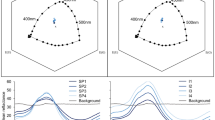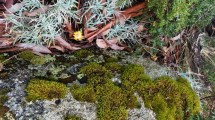Abstract
Color induction in the honeybee is investigated in color discrimination experiments. An individual bee walks in a dark arena and is trained to a self-luminant stimulus presented from below. In the dual-choice tests the dark background is replaced by a colored induction stimulus. Choice behavior is recorded by TV camera and analyzed by computer. Successive color induction is separated from simultaneous induction by analysis of the walking paths. Only successive color induction occurs. Simultaneous effects are not observed. That is a stimulus acts as a color inducing stimulus only when the bee crosses this stimulus. Thus, the color perceived by a given eye region is found to be dependent on the viewing history, but not on the stimuli presented simultaneously on neighboring parts of the retina. Color induction in the honeybee described in terms of selective sensitivity decrease (adaptation) does not explain all behavioral effects induced by the stimulus. The time course of successive color induction is calculated from the exposure times to the induction stimulus and from the choice behavior. The data suggest that color induction is complete after a few seconds. Photoreceptor adaptation is sufficient to explain the observed time course.
Similar content being viewed by others
References
Backhaus W (1991) Color opponent coding in the visual system of the honeybee. Vision Res 31: 1381–1397
Backhaus W (1992) The Bezold-Brücke effect in the color vision system of the honeybee. Vision Res 32: 1425–1431
Backhaus W (1993) Color vision and color choice behavior of the honeybee. Apidologie 24: 309–331
Dittrich M (1995) A quantitative model of successive color induction in the honeybee. J Comp Physiol A 177: 219–234
Goldsmith TH (1963) The course of light and dark adaptation in the compound eye of the honey-bee. Comp Biochem Physiol 10: 227–237
Kindermann U, Hertel H (1986) The time course of dark adaptation in the bee: a phototactic and electrophysiological investigation. Physiol Entomol 11: 23–28
Kühn A (1927) Über den Farbensinn der Bienen. Z Vergl Physiol 5: 762–800
Menzel R, Backhaus W (1989) Color vision in honeybees: phenomena and physiological mechanisms. In: Stavenga DG, Hardie RC (eds) Facets of vision. Springer, Berlin Heidelberg New York, pp 281–297
Menzel R, Greggers U (1985) Natural phototaxis and its relation to color vision in honeybees. J Comp Physiol A 157: 311–321
Neumeyer C (1980) Simultaneous color contrast in the honeybee. J Comp Physiol 139: 165–176
Neumeyer C (1981) Chromatic adaptation in the honeybee: successive color contrast and color constancy. J Comp Physiol 144: 543–553
Scibt U (1967) Der Einfluß der Temperatur auf die Dunkeladaptation von Apis mellifica. Z Vergl Physiol 57: 77–102
Stavenga DG, Kuiper JW (1977) Insect pupil mechanisms. I. On the pigment migration in the retinula cells of Hymenoptera (suborder Apocrita). J Comp Physiol 113: 55–72
Wolf E, Zerrahn-Wolf G (1935) The dark adaptation of the eye of the honeybee. J Gen Physiol 19: 229–237
Zielinski R (1978) Erzeugung von Zufallszahlen. Deutsch, Frankfurt/Main
Author information
Authors and Affiliations
Rights and permissions
About this article
Cite this article
Dittrich, M. Time course of color induction in the honeybee. J Comp Physiol A 177, 207–217 (1995). https://doi.org/10.1007/BF00225100
Accepted:
Issue Date:
DOI: https://doi.org/10.1007/BF00225100




